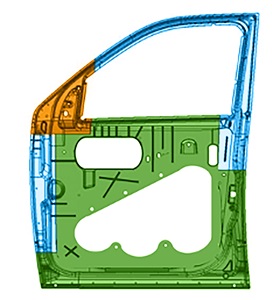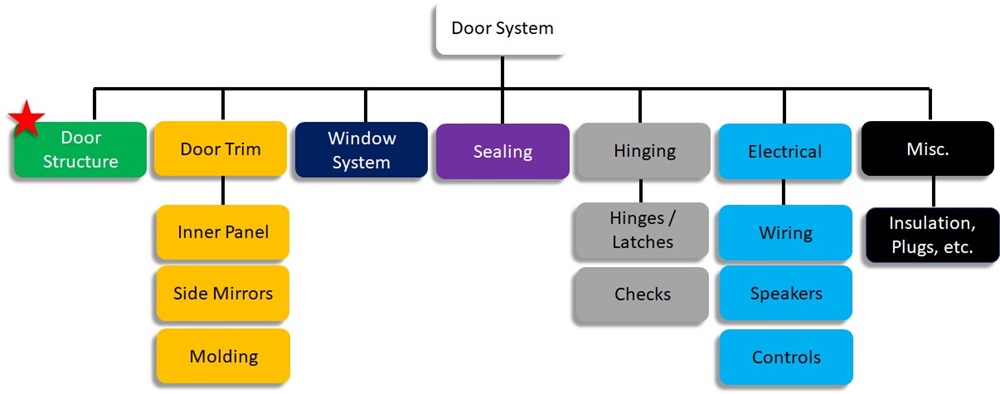Lightweight Steel Door Design Study – Opportunities for mass/cost efficiency with optimized steel closures
 However, greater opportunity exists with the ability to avoid complexity while achieving lightweight steel doors through:
However, greater opportunity exists with the ability to avoid complexity while achieving lightweight steel doors through:
- Optimized clean sheet design
- Advanced forming and joining
- High strength / high ductility 3rd generation Steel
Automakers are constantly searching for means to reduce vehicle weight to improve fuel economy and reduce CO2 emissions in the case of conventionally powered vehicles or, to increase driving range in the case of battery electric vehicles. Additional benefits such as improved vehicle driving dynamics and increased cargo carrying capacity are equally important but generally vary by vehicle mission and brand. Side closure structures (doors-in-white) are frequently the target of weight reduction efforts. Since these are bolted onto the structure, they do not impact the mainline in body shop and may be manufactured using any material without affecting the existing infrastructure. This allows automakers the flexibility to manufacture door structures using any material consistent with their weight reduction targets and overall business strategy.
Although steel doors still dominate the landscape, aluminum doors recently became a lightweighting choice in certain segments albeit at a considerable cost premium. This prompted the steel industry to embark on a series of investigations to study new and creative means of offering the automakers more cost effective and weight efficient steel door solutions that meet, or exceed, their expectations.
As shown in figure (1) below, a vehicle door system (dressed door) is fairly complex and consists of a door structure and other non-structural components. The main component typically targeted for material substitution is the door structure which is designed to meet multiple performance requirements such as,
- Crashworthiness (FMVSS 214, side pole impact, and side barrier impact)
- Strength (Door sag, wind gust loads, outer panel denting)
- Durability (Door opening and closing over the life of a vehicle)
- Stiffness (Frame stiffness, beltline stiffness, side mirror mounting stiffness, torsional stiffness, resonance frequency, outer panel oil canning)
- Acoustics (wind and road noise isolation)

Figure (1): Example of a Vehicle Door System
Reference [1] is a fairly comprehensive study of automotive closures’ mass benchmarking using statistical methods. In the case of doors, the study concludes that while aluminum door structures may offer up to 30 percent reduction in weight over steel door structures, that weight reduction is not fully realized at the door system level. If the objective is to reduce overall vehicle weight, one then has to wonder about the real value of using aluminum especially when the cost of executing an aluminum door would be considerably higher.
In a recent engineering study, AISI and its partners redesigned an existing steel door using state-of-the-art analysis and optimization methods and exploiting the broad spectrum of commercially available high strength steel (HSS) grades. Manufacturing technologies such as laser welded blanks, tailor rolled blanks, and adhesive bonding were also utilized in developing the lightweight steel door concept.
Starting with a production steel door design (baseline) weighing around 20 kg, AISI and its partners were able through a series of optimizations (including; load path topology, geometry, gauge, and grade) to develop a design concept which met, or exceeded, the performance of the baseline. Thorough benchmarking of average, and efficient, steel and aluminum doors coupled with the detailed CAE analyses, uncovered new features and opportunities for the new steel intensive solution. The new design featured a 0.55 mm thick door outer using a high strength bake hardenable steel grade (BH280/400) for improved dent resistance. The door inner panel featured; a curvilinear laser welded blank for optimum gauge distribution, a high strength low alloy steel grade (HSLA 350/450) to meet set targets, localized optimized beads for improved stiffness, and an optimized load path topology. The new inner panel design by itself accounted for around 50 percent of the weight savings. Redesigned reinforcements also contributed to weight savings. These included; a new HSLA 350/450 beltline reinforcement designed as a continuous section, DP780 steel hinge reinforcements with optimized beading, and a tailor rolled blank (TRB) and shape optimized PHS 1900 intrusion beam. The redesign also featured improved performance through the use of structural adhesives. Applied stiffening patches, an additional belt line reinforcement, and extra brackets for header stiffness improved overall door stiffness but resulted in some weight add.
The result was a new door design that weighed just below 15 kg, representing over 25 percent reduction in weight. Forming simulations and physical stamping tryouts confirmed that all major panels in the new design were formable at the specified grade and gauge combinations. Furthermore, assembly trials also did not reveal any hemming concerns. Finally, the process based technical cost analyses showed that the new concept was equal in cost to the baseline. Table (1) below, highlights some key differences between the new design and the baseline.

Table (1): Baseline vs. New Design Concept
While this study was limited to the redesign of an existing production door, a more efficient solution, without the unnecessary complexities, may be achieved through an optimized clean sheet door design that utilizes the full spectrum of contemporary steel grades (including high strength / high ductility 3rd generation steel grades) and advanced forming and joining technologies.
[1] Mass Benchmarking Using Statistical Methods Applied to Automotive Closures, Malen & Hughes,
SAE2015-01-0574
![[AISI LOGO]](https://www.steel.org/wp-content/themes/steel-org/assets/images/steel-logo.png) American
Iron and Steel
Institute
American
Iron and Steel
Institute